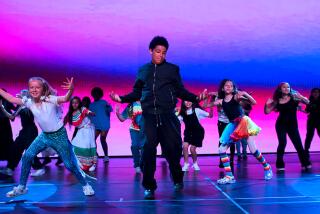DANCE REVIEW : Final Program in Kaleidoscope Series
Instead of once again succumbing to excess, Dance Kaleidoscope unexpectedly satirized it during much of the showcase series’ final 1989 program Saturday in the Cal State Los Angeles Playhouse.
Consider Gregg Bielemeier’s wry new solo, “A Place for Everything and Everything in its Place . . ,” with its mock-serious anthology of the most flagrant mannerisms and cliches found in ballet, pop dance and the avant-garde. Emerging from the parody of choreographic styles came a bitter question very specifically expressed in sound and motion: Is the contemporary dancer merely a dog executing tricks?
Jacqueline Planeix and Thomas Crocker (a.k.a. Blue Palm) seemed to answer affirmatively through their suite from “Dance Talks,” in which the demeaning, lifelong duplicities inflicted on dancers were boldly articulated in speech and illustrated with movement.
Finally, the Shrimps’ inspired outdoor intermission epic “Bluff” reduced the preoccupation with sex-war in contemporary modern dance to a series of assaults by teams of morons in their underwear. Sometimes they even wielded giant, shockingly phallic legumes--but don’t tell Sen. Jesse Helms.
Unfortunately, the Shrimps, Blue Palm and Bielemeier didn’t get around to satirizing some of Kaleidoscope’s own programming sins. Where were they during Ka-Ron Brown Lehman’s solo “A Piece of Sky,” for instance?
This slick, sure-fire collage of Alvin Ailey hallmarks featured the customary lady in a long white dress (here the valiant Jessica Vallot) doing the usual, frenzied circle-kicks--accompanied, as always, by a blaring pop ballad. Perhaps Lehman should formally acknowledge her source by re-titling the work “A Piece of ‘Cry.’ ”
More original, though ultimately no more satisfying, Patricia Sandback’s solo “Toward Stillness” (well danced by Debi Toth) used walking passages to punctuate sequences of rhythmic keening and other vividly projected gestural imagery. However, the components remained isolated statements and the solo itself a curiously incomplete experience.
Equally fragmentary was Tina Gerstler’s “Eclipse,” a brief, fluid structuralist quartet, neatly performed, with some tentative expressive content occasionally evident. Gerstler aimed for a cosmic perspective on human relationships, but by using intense embraces merely as formal motifs--and never suggesting anything about the participants--her work looked at once overblown and trivial.
If Dance Kaleidoscope gave a prize for reckless ambition, it ought to go to Antony Balcena for “Dudes.” This movement-theater extravaganza not only dared to repudiate every vestige of gay pride in its uncompromisingly downbeat portrayal of homosexual relationships, it also emphasized the most horrific elements of the AIDS crisis.
Balcena proved highly imaginative in physicalizing thorny socio-sexual issues, but his grotesque finale needs to be revised--if only because it closely duplicates the ending of Gerald Arpino’s apocalyptic ballet, “The Clowns.”
Completing the program: “Departure of the Youngsters,” John Malashock’s deeply personal exploration of power and manipulation, recently reviewed in these pages.
A former Tharp dancer, Malashock is one of the major talents to arise in Southern California since Dance Kaleidoscope folded two years ago. His presence on the final program offered potent evidence that this newly revived series must continue as a means of introducing (and developing) new artists for a wider audience.
More to Read
The biggest entertainment stories
Get our big stories about Hollywood, film, television, music, arts, culture and more right in your inbox as soon as they publish.
You may occasionally receive promotional content from the Los Angeles Times.










